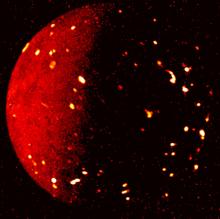Listen to today's episode of StarDate on the web the same day it airs in high-quality streaming audio without any extra ads or announcements. Choose a $8 one-month pass, or listen every day for a year for just $30.
You are here
Moon and Jupiter
The Atlantic hurricane season opens on June 1st. Its giant storms can span hundreds of miles and last for days.
But a Jupiter-orbiting spacecraft has discovered regions where it’s always hurricane season, the storms can span thousands of miles, and they don’t seem to have an expiration date.
Juno arrived at Jupiter almost two years ago. It orbits the giant planet once every 53 days, from pole to pole. That allows it to see regions of Jupiter that haven’t been seen before: the north and south poles. And the view is amazing — a giant cyclone sits atop each pole, with other big cyclones all around them.
The central storm at the north pole is boxed in by eight other storms, all of which are at least 2500 miles across. The storms actually form two boxes. They’re offset by 45 degrees, with one box a little smaller than the other.
The storm at the south pole is surrounded by five other cyclones, which are a bit more randomly distributed. They’re also bigger than their northern kin: up to about 4300 miles across.
Juno has watched the storms for months, and seen little change. No one is sure why the storms around the central ones are there at all, or why they don’t merge — mysteries for Juno to continue exploring as it looks down on the stormy poles of Jupiter.
And Jupiter looks like a brilliant star close to the right or upper right of the Moon at nightfall, and staying close to the Moon throughout the night.
Script by Damond Benningfield





